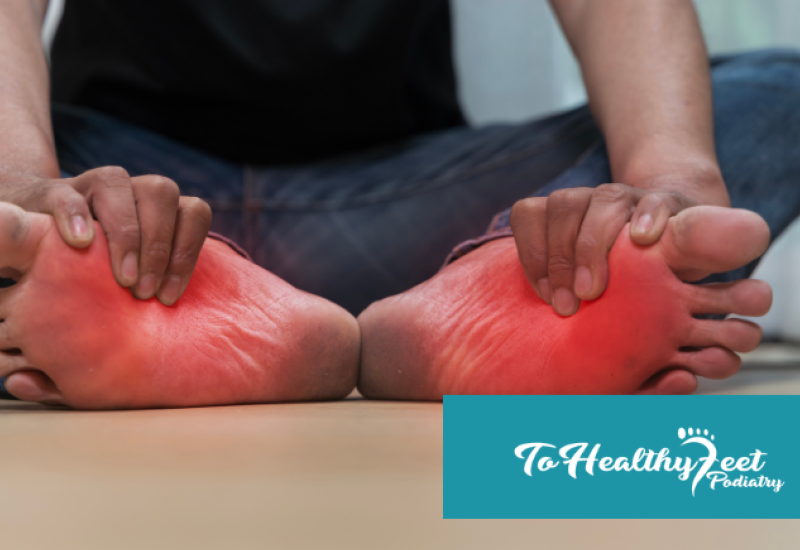Athlete’s Foot (also known as Tinea Pedis) is a very common foot condition. Sometimes the symptoms can be overlooked but treatment is easy and Athlete’s Foot should not be ignored. If you are experiencing the symptoms of Tinea Pedis consult with your podiatrist and minimize the chance of recurring infections. Don’t get sidelined from your favorite activities with the itch and irritation caused by Athlete’s Foot. The foot doctors at To Healthy Feet can provide you relief with treatment options.
Contact our clinic today to schedule your appointment!
You don't have to suffer from the uncomfortable and irritating symptoms of Athlete’s Foot. Treatments are available and prevention is key.
Signs And Symptoms
Athlete’s Foot often presents as a scaly, red rash between the toes. This rash can be itchy or burning and is typically worse at night and right after shoes and socks are removed. More severe types of Athlete’s Foot can cause blisters or ulcers and chronic dryness or scaling on the soles and sides of the foot. When left untreated, secondary bacterial infections can occur.
Causes
Tinea Pedis is a fungal infection. This same fungus is the cause of ringworm and jock itch and it thrives in warm, humid conditions like those created by wearing damp socks and tight-fitting shoes. Athlete’s Foot is contagious and can be spread from person to person or through contact with contaminated surfaces like change room floors or through contact with towels, socks, and shoes.
Complications
Scratching or picking at your infected foot can lead to transmission to your hands causing similar symptoms there. The fungus can migrate to your toenails causing nail fungus that can be more difficult to treat. The infection may also spread to your groin if you use the same towel on your feet and other parts of your body. More severe symptoms like cracked skin may occur if treatment is neglected or not effective.
Treatments
Athlete’s Foot can usually be diagnosed with a visual examination of the affected area and confirmed with further testing if necessary. The first course of action is typically treatment with a topical antifungal ointment. Topical therapy should be combined with careful foot care; washing the feet twice daily and drying thoroughly especially between the toes before applying. Treatment will likely last a couple of weeks and if the topical application is not effective, an oral antifungal medication can be prescribed.
Prevention
Ease the symptoms and prevent recurrences with these tips:
- Keep Feet Dry: Dry your feet thoroughly after showering or bathing and go barefoot whenever possible.
- Keep Shoes Dry: Wear lightweight and well-fitted shoes. Avoid tight shoes and footwear made of materials such as rubber and vinyl that impede airflow. Allow time for shoes to dry before wearing again.
- Change Your Socks Often: Whenever your feet feel sweaty or damp, change your socks. And consider carrying extra pairs, so your feet never remain moist for too long. Natural cotton and moisture-wicking materials are best.
- Safeguard Your Feet In Public Spaces: Avoid walking in areas of high transmission like pools and locker rooms, or wear sandals or shoes in public places.
- Nurture Your Feet: Keep your nails trimmed, soak your feet with Epsom salts, wash your feet twice daily, and use antifungal foot powder to keep your feet dry.
Conclusion
Don’t let Athlete’s Foot stop you from enjoying your favorite activities. Our New York foot doctors can diagnose and treat your infection in-office at our Downtown or Midtown Manhattan locations or with a virtual consultation. Contact our office or book online and don’t suffer the disruptive symptoms of Athlete’s Foot any longer.
Frequently Asked Questions:
Will my Athlete’s Foot come back? Athlete’s Foot can recur and you may be more susceptible if you have had it before. Practice diligent prevention to avoid this, but treatment is available if you need it.
Is this contagious? Yes, Tinea Pedis is contagious and can be spread through direct contact or contact with contaminated surfaces. Disinfect common areas like showers and bathroom floors and do not share towels, socks, or shoes. Wash your hands thoroughly after touching your feet.
Can non-athletes get Athlete’s Foot? Yes. Named Athlete’s Foot because locker rooms and pool change areas are common places for transmission, this is a fungal infection that can be transmitted through contact with any surface contaminated with the fungus.



